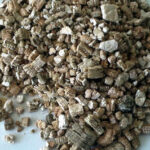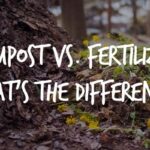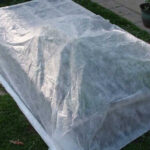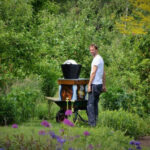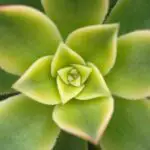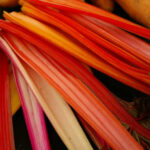When it comes to bacterial and fungal diseases in the garden, there isn’t much you can do in terms of treatment other than throwing out the plant’s infected parts. Fortunately, for gardeners, you can take preventative measures to stop a disease before it spirals out of control. One of the products you can use is copper fungicide. It’s safe to use for organic gardening, but there are some precautionary measures to take when you use it.
Copper fungicides won’t solve all your problems, such as late blight in tomatoes, but they’ll at least slow or stop the spread of diseases such as powdery mildew, downy mildew, black spot, rust, fire blight, and anthracnose, among many other listed diseases you might find in your garden.
There are many different kinds of copper fungicides, although there are a couple of types of liquid copper fungicide that are readily available for residential gardeners. The other forms typically can only be purchased by commercial growers.
Let’s take a look at how you can use copper fungicide in your garden, along with the potential problems it can cause.
What Is Copper Fungicide?
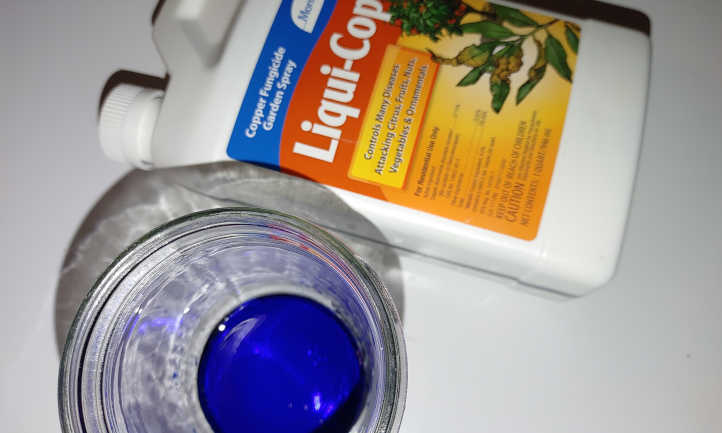
Copper fungicide isn’t just one singular product. It’s a category of products with copper as an active ingredient used to prevent bacterial and fungal diseases to save your garden. The active ingredient is the positively charged copper ion, Cu+2. Bacteria and fungi are sensitive to this copper ion, which stops spreading when you apply the fungicide.
Copper is a metal that comes from the earth, so if you prefer using organic methods, it’s safe to use, and most brands of copper fungicide are OMRI-rated and as such approved for use in organic settings. However, moderation is key. As an example, sugar is organic but it’s bad for you to consume in large amounts. Copper is the same when it comes to applying it to your garden. Copper products don’t break down in the soil in the same way or with the same speed that many other products do. As a result, they can eventually contaminate the soil and harm your plants if you apply too much all at once.
How Does Copper Fungicide Work?
Every living organism needs trace amounts of copper to survive. One of the reasons people need it is to form red blood cells. But, too much copper is a bad thing, and that’s how copper fungicides came to be.
The organisms that infect your garden include algae, bacteria, mold, and fungi. They’re tiny organisms, so it only takes trace amounts of copper to kill them. The copper penetrates the membranes and disrupts enzymes, causing the microorganisms to die.
Fortunately, the amount of copper fungicide you’ll apply to your garden won’t be enough to kill your plants or harm you or your pets, only the bacterial or fungal disease you’re trying to treat. There is a limit, but you likely won’t find it any time soon. Still, you should be sure to have protection such as masks, eye protection, and long sleeves while you apply it.
As you apply copper fungicides to your garden, you may notice that new growth is negatively affected. This is because mature leaves have a protective waxy layer that stops copper ions from penetrating the leaf. New growth doesn’t have this layer yet, so it’s more likely to get damaged. However, new growth is also at higher risk of disease spread, so you still want to treat it, just safely.
Copper ions get released when the residue on the plants gets wet. Plants treated with copper products and left in wet conditions are also more likely to suffer damage. This is why it’s so essential that it be applied when the weather is warm and the sun is out.
Types Of Copper Fungicide

Liquid copper fungicide is the most readily available form for residential gardeners. Most of these products will be in the ready-to-use (RTU) form or as a concentrate you have to mix with water.
There are also granules you can mix into water, but these are typically only available for commercial growers. RTUs and concentrates have small amounts of copper, while granules usually have higher amounts that are generally more toxic and riskier to use.
The two liquid forms you’ll see in stores are copper ammonia diacetate complexes or Bordeaux mixtures.
Copper Ammonia Diacetate Complexes
These copper fungicides contain about 30% of copper ammonia diacetate complex. The percentages may vary between brands, and when in a ready-to-use format are usually significantly less due to the addition of water. Popular ready-to-use brands are Southern Ag and Copper-Count-N.
Copper Octanoate
Another common residential blend of copper fungicide is copper octanoate. In the diluted or ready-to-use forms, there’s usually less than 1% of the active ingredient in the solution, but concentrated versions contain up to 10%. Popular ready-to-use brands are Monterey and Bonide.
Bordeaux Mixtures
Bordeaux mixtures are made of copper sulfate, lime, and water. They usually contain less copper than copper ammonia diacetate complexes with around 25% copper. This kind of copper fungicide was the first ever used, dating back to the 1800s. It may leave a blue-green stain, but it can stay in place much longer after rain than other copper fungicide types can.
Other Copper Fungicides
There are a few other copper fungicides available, but these are the kinds that typically can’t be used for residential purposes. We’ll list them so you can learn more about them if you’d like, but you’ll probably only use the previous types we mentioned.
The other forms come in water-dispersible granules. Granules are mixed into water and then sprayed on crops. There’s copper hydroxide, copper oxide, and copper oxychloride. Each type has a different level of copper. Copper oxide is the most concentrated type available with about 83% copper.
Benefits Of Using Copper Fungicide
While there are many things to be careful about when using copper fungicides, there are plenty of benefits that make them worth using. For starters, they can be used to treat almost any plant. They’re great for vegetables, roses, fruits, nuts, herbs, and other plants.
Copper fungicides are approved to use for organic gardening, so if you prefer to stick to natural gardening methods that don’t use chemicals, copper fungicide will be your friend.
The biggest benefit that will draw you to use copper fungicides is that they can be used to treat symptoms of almost any bacterial or fungal disease, although it won’t work for late blight in potatoes and tomatoes. Many, if not all, diseases don’t have a singular true cure, but instead, utilize an integrated plant management system to control the spread. The only way to get rid of infections is to remove the infected plant tissues or in severe cases the entire plant, and to try to prevent them from spreading to and developing on other nearby crops. Copper fungicides can act as a preventative against bacterial and fungal diseases when you coat the entire plant. Be sure to evenly coat all plant tissues, as uncoated portions are still susceptible.
Bacterial and fungal diseases are prone to spread with consistent wet weather or persistent pests. Applying copper fungicide before pests and wet weather appear is helpful and will protect your plants. Timing is essential with this prevention method, but it’s well worth it in the end when you get it just right.
Drawbacks Of Using Copper Fungicide
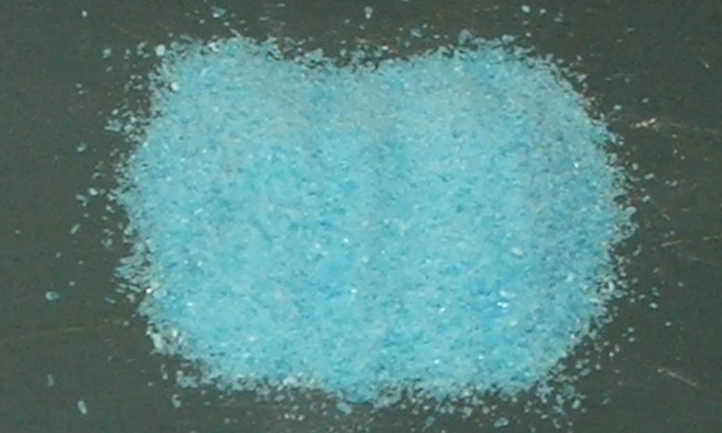
Many will agree that chocolate is delicious, but too much will leave you with a stomach ache and regret. Copper fungicide works similarly: it’s good until you overdo it!
As we discussed earlier, copper fungicide is effective because it’s toxic to microorganisms that make up a bacterial or fungal disease. The amount it takes to kill off these microorganisms is minuscule, and it’s not enough to harm you or your plants. However, medium or large quantities can hurt yourself, plants, animals, and the environment. Strictly follow the directions on the product label, and you won’t run into any issues.
Copper fungicides can contaminate soil that’s rich with organic material, but could run off into groundwater in minerally-based soils. Typically, they don’t break down in the soil in the same way as other products. This is why you should always be incredibly careful about where you apply the spray. Only spray stems and leaves to limit how much fungicide comes into contact with the soil. If you plan to use copper fungicides regularly, consider utilizing crop rotation to swap between susceptible and resistant species so you don’t apply the sprays in the same beds each year. If you’re concerned about metal buildup in the soil, a laboratory soil test can be beneficial in determining if you’ve applied too much. On the bright side, your garden will also use small amounts of copper as a micronutrient over time, so if you’re careful, you shouldn’t have any major issues.
Sometimes, plants can become damaged by copper. The waxy surface on leaves usually protects them from injury, but some fungicides use surfactants, or spreader-stickers, to help the fungicide stick to the plants better (more details about this in the next section). Surfactants allow the copper to spread over the plant tissues and enter through their stomates, or pores. In excess, this can result in hurting the plant. Be sure that if you’re using concentrated forms they’re limited to the manufacturer’s recommended dose dissolved into a gallon or half-gallon of liquid (per instructions), as this limited quantity will be helpful and not harmful.
Finally, some copper fungicides can be harmful to bees, which is something every gardener tries to avoid. To keep the bees safe, avoid putting spray directly on flowers or anywhere else you see bees land frequently. Bees don’t usually stop on leaves and stems, so following the label directions will help keep them safe. Copper sulfate is the most harmful for bees, but this is one of the fungicide forms that aren’t readily available to residential gardeners, so you won’t have to worry about that too much. Most ready-to-use or concentrated copper fungicide formulas in the United States are either copper octanoates or copper ammonia diacetates.
How To Use Copper Fungicide
When using a copper fungicide, always follow the label directions for the best results. Even though small amounts of copper won’t hurt people and pets, you should still wear protective clothing and gear and keep kids and pets out of the area while you’re applying the product and while it’s still wet.
The best time to apply copper fungicide is in dry weather before you see signs of disease or when you first see it appear. Don’t put it on new growth because it will be more susceptible to injury since it won’t have a protective waxy coating on the leaves.
If you have a ready-to-use product, you won’t have to do anything but spray the fungicide on your plants.
If you have a liquid concentrate product, you’ll need to mix it with water before you can spray it. The ratio may vary between brands, but you’ll likely need 1-2 tablespoons per gallon of water.
It can take up to 12 hours for the spray to dry, so be sure to wait for a clear, dry day before you apply it or it won’t be as effective. If the weather is dry and the humidity is moderate to low, it will dry within only a few hours. You’ll most likely need to reapply the fungicide during dry weather every 1-2 weeks if there is a consistent risk of infection. Be sure to read the directions before you reapply.
When possible, prune off material that shows visible signs of heavy bacterial or fungal disease prior to application. Only spray the stems and leaves of the plants, making sure to avoid soil and flowers to prevent soil contamination and harming bees. If you have concerns about how much copper is in your soil, you can purchase test kits online and test your soil periodically. Annual testing will allow you to keep an ongoing record of copper levels in the soil so you can plan your garden accordingly.
Frequently Asked Questions
Q: When should I apply copper fungicide?
A: Apply the fungicide in dry, clear weather on mature plants before you see the disease or when you see the first signs of diseases starting to form.
Q: How fast does copper fungicide work?
A: Copper fungicide works best once it’s dry, which can take up to 12 hours. If the sun is out and the weather is warm, it may dry much faster. Cloudy or cool days, or high humidity levels, will slow the drying process after the plant is treated. Remember that it’s not a cure, per se, but instead a treatment for the disease or a preventative if applied in advance.
Q: Is copper fungicide safe for all plants?
A: When used as directed, copper fungicide is safe for all types of plant. Too much may harm them, which is why it’s so important only to use as much as directed.
Q: Is copper fungicide safe for humans?
A: The small amount you’ll be using for your plants won’t be enough to hurt you, but large amounts can hurt you. Never drink copper fungicide and wash thoroughly after applying it. Wear masks, gloves, and protective clothing while you’re applying it to stay safe. It’s best to keep children out of the area until the product is completely dry.


